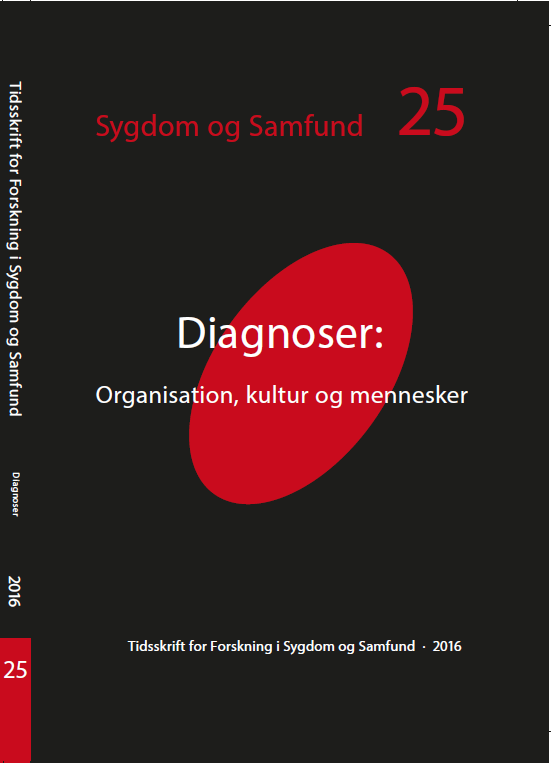Gir pålitelige tegn gyldige diagnoser? Den psykiatriske revolusjonen og bruk av diagnoseverktøyet SCID på en massemorder
Publiceret 2016-12-08
Citation/Eksport
Resumé
Både reformen av den amerikanske diagnosemanualen Diagnostic and Statistical Manual of Mental Disorders (DSM) i 1980 og utviklingen av diagnoseverktøy basert på denne reformen, som Structured Clinical Interview for DSM Axis I Disorders (SCID I), har blitt kalt en revolusjon innenfor psykiatrien. Det viktigste med denne revolusjonen var at den la til grunn observerbare tegn og symptomer for diagnostiseringen. Den skulle, som de viktigste pådriverne for endringen framhevet, ”focus on observable behavior only”, og ikke gjøre slik psykatrien hadde gjort tidligere, å fokusere på ”unconscious processes.” Med fokus på det observerbare skulle psykiatriens diagnoser og verktøy bli mer pålitelige. Revolusjonen var en epistemologisk transformasjon. Denne artikkelen viser at den også var en ontologisk transformasjon. Grunnlaget for å fokusere på ”observable behavior only” var en tillit til statistiske analyser og at sykdommen ville vise seg gjennom et bestemt antall forekomster av tegn og symptomer. Fra et statistisk grunnlag som i høyden kunne brukes til å si noe om sannsynlighet for en sykdom, ble bestemte fordelinger av tegn brukt som grunnlag for å konkludere om bestemte sykdommers 156 Tidsskrift for Forskning i Sygdom og Samfund, nr. 25, 157-171 eksistens. Gyldigheten til sykdommer ble basert på statistiske beregninger av forekomster av observerbare tegn. Artikkelen problematiserer både det epistemologiske og ontologiske grunnlaget for denne revolusjonen gjennom en studie av de vitenskapelige arbeider og begrunnelser som ledet fram til transformasjonen, samt ved studie av diagnoseverktøyet SCID i bruk. SCID blir studert gjennom bruken av verktøyet på massemorderen Anders Behring Breivik. Dette caset er et unikt materiale siden SCID ble brukt to ganger av to forskjellige team av psykiatere, og med diametralt forskjellig utfall. Caset brukes dermed til å tydeliggjøre svakhetene med grunnlagstenkningen.
Do reliable signs give valid diagnoses? The psychiatric revolution and the use of its diagnostic instrument on a mass murderer
The reform of the American diagnostic manual for mental illnesses, Diagnostic and Statistical Manual of Mental Disorders (DSM) in 1980 and the development of psychometric instruments based on this reform, like the Structured Clinical Interview for DSM Axis I Disorders (SCID I), has been called a revolution in psychiatry. The most important element in this revolution was that the diagnostic criteria was based on a knowledge production that “focus on observable behavior only”, and not, as psychiatry had done earlier, with “reference to unconscious processes.” By focusing on the observable, the diagnostic criteria and instruments in psychiatry should become more reliable. The revolution represented an epistemological transformation. This article shows that it was also an ontological transformation. The grounding for focusing on “observable behavior only” was a trust in statistical analyses and a belief that a specific illness could be found from specific number of appearances of signs and symptoms. From a statistical grounding, which could be used for saying something about the probability of an illness, specific distributions of signs were used for claiming the existence of illness. The validity of illnesses was based on statistical distributions of observable signs. This article problematizes the epistemological and ontological grounding of this revolution through a study of the scientific publications leading to the revolution and also by studying the use of the diagnostic instrument SCID. The latter is studied through the case of the mass murderer Anders Behring Breivik. This case gives a unique material, as Breivik was tested twice by two different psychiatric expert teams, but with diametrically opposed outcomes. The case is used to make evident some of the inherent weaknesses of the grounding.

